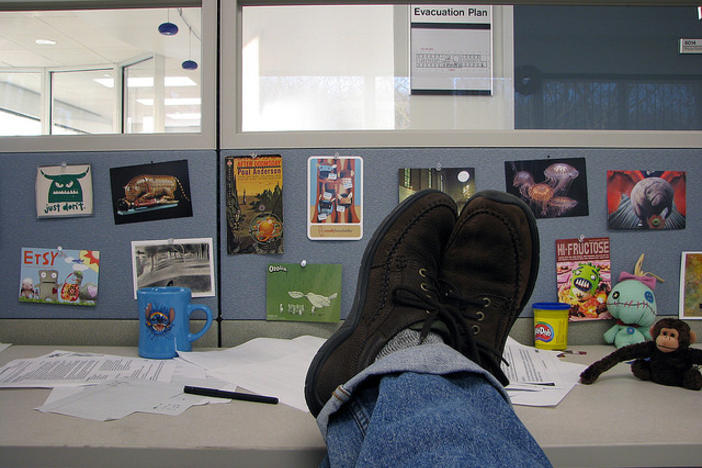
Section Branding
Header Content
How To Get A Busy Boss To Listen To You
Primary Content

Busy bosses are all too common these days. I consistently hear managers of all shapes and sizes, good and bad, tell me that with the immense amounts of work on their plate, they simply don’t have time to meet with their direct reports. So, whether you are a Vice President looking to get time with the “head honcho” or you are just starting out your career, time with the boss is a rare thing. And just because you get time with him or her, with all of the distractions at work today the odds they will truly “listen” to you drop even more dramatically. So, what can you do?
I’m an analogy guy (if you haven’t already figured that out). The approach to getting a busy boss to listen to you is just like the approach a master chef might take in preparing the perfect irresistible three course meal for his or her most valued customer. Get your apron on and your pots and pans ready. We’re off to the kitchen.
Know Your Boss and His/Her Palate
Understanding your boss’ information “dining habits,” is the first step. What does he or she like to talk about? When do they like to talk with you (when they do)? How much do they like to get from you (portion size)? Understanding these basic but important traits will help us whip up the perfect menu that will leave them sitting on the edge of their seat, begging for more.
Plan Your Menu and Offer a Taste
Understanding what your boss likes to talk about is the second step. Our goal is to use this to tantalize our boss with a juicy “starter” to get their attention. In other words, you want to lead the conversation with what he or she wants to talk about. If he or she always is asking about the status of a particular project, start there. If he or she always wants to talk about sales numbers, make that first. You get the idea. When in doubt, consider numbers. As one colleague reminded me, “few things attract more attention than cold, hard numbers…good or bad.”
Send out this “appetizer” in a very small portion in the version of an e-mail or voicemail to flag that you want to talk more about this and provide them just what they are looking for. For example, “I’m looking forward to reviewing the status of Project X with you. To date, I’m pleased to report that we are 14% ahead of target. I’d like to fill you in on the details and give you my estimated projections when we meet…” Get them hungry, not full.
Pick the Ideal Dining Time
Picking the right time to meet with your boss is also important. In your “appetizer” e-mail, request a time that you know will be the most productive for your boss. In other words, consider times / locations that will be free from other distractions (for example, don’t pick a time right after they are scheduled to meet with their boss. Those meetings almost always run over and can leave your boss in an unhappy mood). Also consider times that are less likely to get moved or bumped by other meetings or emergencies. Good “bump free” times include: first thing Monday morning, end of the day Friday or in the early morning hours / early evening hours.
Leave Them Wanting More
Once you have them committed to a time and place, be thoughtful about what you are going to serve and when. If you stay in control of the kitchen, you are more likely to get them to hear what you want them to hear. Above all, keep your portion sizes small. It’s better to have them wanting more than for them to leave feeling like they want to throw up. Consider the following sample menu (including portion size):
- First Course (Appetizer) – What they want to talk about. Less than 10 minutes
- Second Course (Main Course) – What you want to talk about. Approximately 10-15 minutes
- Third Course (Dessert) – Offer a menu of possible next steps. Ask them what they would like to do next based on the conversations you’ve had. Approximately 5 minutes
Always set up the meetings to be less than you would like (small portions). And as any good chef would, send the “menu” (agenda) ahead of time and manage it as tightly as you can. If he / she starts to go off of the agenda, don’t be afraid to say, “I notice that our conversation is turning in a different direction. I’m sensitive to your time. Might I propose that we quickly conclude what’s on our current agenda and then use the remaining time for this additional topic?”
Thank Them for Dining with You
After the meeting, send a follow-up e-mail that outlines what you covered, what they / you committed to doing based on the conversations and proposed next steps / meeting times. This not only reinforces your message to ensure “stickiness,” but it more likely guarantees a future meeting.
There you have it: the recipe for getting a busy boss to hear you. One final note, just as a good chef would never serve “rotten” food, avoid outdated information or irrelevant content. The last thing you want is for them to spit out what you’ve served them, push themselves away from the table and walk out. Getting them to dine with you again will be nearly impossible.
So, what are you waiting for? Get cookin’!
Secondary Content
Bottom Content





